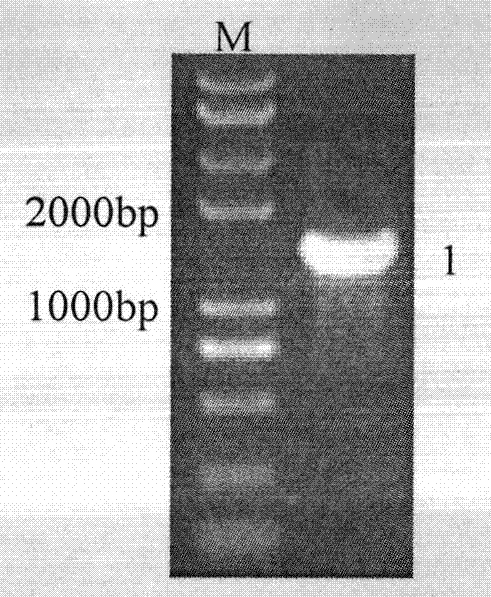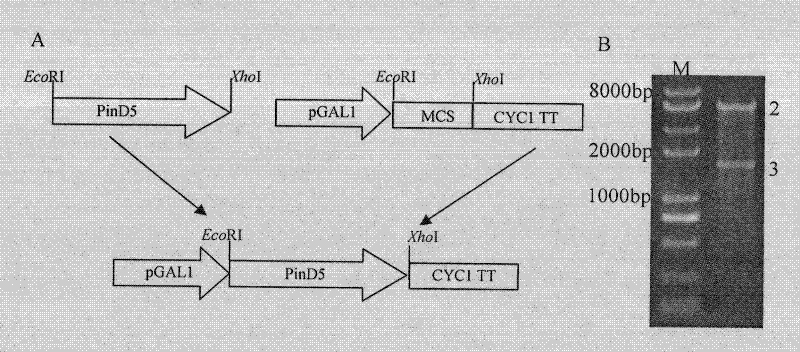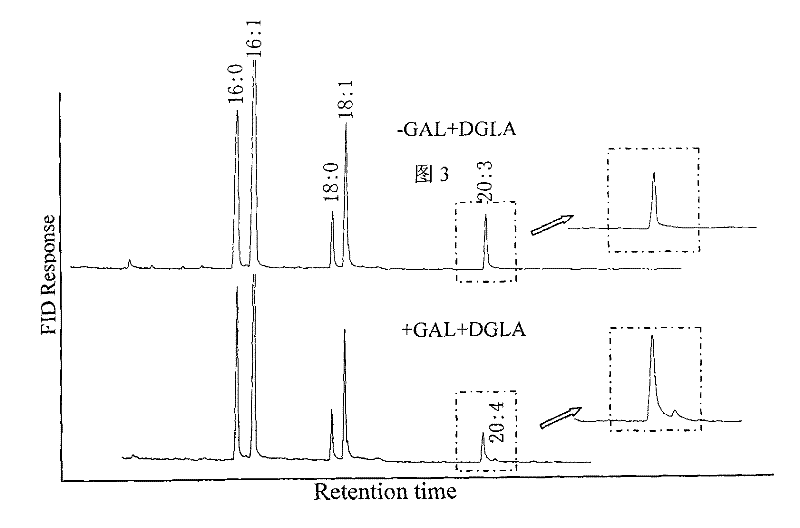Function identification and application of delta-5 desaturase gene PinD5 of Phytophthora infestans in potato
A technology of Phytophthora infestans and desaturase, which is applied in the fields of molecular biology and biology, and can solve problems such as the inability to synthesize ultra-long-chain polyunsaturated fatty acids.
- Summary
- Abstract
- Description
- Claims
- Application Information
AI Technical Summary
Problems solved by technology
Method used
Image
Examples
Embodiment 1
[0130] Example 1: Acquisition of Phytophthora infestans Δ5 desaturase gene PIND5
[0131] 1. Cultivation of Phytophthora infestans potato: Inoculate Phytophthora infestans potato into fresh oat medium, cultivate in dark at 20 degrees.
[0132] 2. Extraction of total RNA: the mycelia grown for about 15 days were collected, and the total RNA was extracted by using the TRIZOL method (invitrogen).
[0133] 3. Take 2 micrograms of total RNA and use MMLV Reverse Transcriptase (Promega) to reverse transcribe into single-stranded cDNA.
[0134] 4. Using the obtained cDNA of Phytophthora infestans as a template, use primers 5'-ATGACCACGGATGACATCAC-3' and 5'-CTCGAGTTAGCCCATGTGGACGGT-3'; PCR system: ddH 2 O 35.5μl; 10xPCRbuffer (containing Mg 2+ ) 5 μl; dNTP (2.5 mM) 4 μl; each primer (5 μM) 2 μl; template 1 μl; Taq enzyme 0.5 μl. Reaction conditions: pre-denaturation at 94°C for 3 minutes; denaturation at 94°C for 30 seconds, annealing at 65°C for 30 seconds, extension at 72°C for 1 ...
Embodiment 2
[0137] Example 2: Phytophthora infestans Δ5 desaturase gene PinD5, the following sequence:
[0138] (1) Information of SEQ ID NO.1
[0139] (a) Sequential features
[0140] * Length: 1551 bp
[0141] *Type: nucleic acid
[0142] * Chain type: double chain
[0143] *Topology: Linear
[0144] (b) Molecular type: cDNA
[0145] (c) Assumption: No
[0146] (d) Antisense: no
[0147] (e) Original source: Phytophthora infestans
[0148] (f) Sequence description: SEQ IN NO.1
[0149] 1 ATGACCACGG ATGACATCAC ACTCCAATTC GCACTCACGG CCGGAAAGAC CATCGGAACC
[0150] 61 TCTGCTTCCC CTGCATTGTC ACCACTAATT GACGAAGTAG AAGCTGCCAT GGCCCCTATC
[0151] 121 GAGACCGAGA AGACCATCGT TAACGAGGGT CTTTACCAGC GCAAGACTGC TGCTGATGCA
[0152] 181 GCTACTAACA AGTCTGCCGC CACCTACACG TGGCAGGACG TGGCCAAGCA CAACACAGAC
[0153] 241 AACAGCGCTT GGGTCATCAT CCGCGGAATC GTATACGACG TAACTGAATG GGCGGATCGC
[0154] 301 CACCCTGGAG GCCGTGAACT CGTGCTGCTG CACTCTGGTC GCGAGTGCAC CGACACATTC
[0155] 361 GACTCGTACC ACCCATTCTC...
Embodiment 3
[0253] Embodiment 3: Construction of yeast expression vector pYES2-PinD5
[0254] 1. Use EcoRI and XhoI to excise the fragment from the pMD18-T vector containing the PinD5 fragment constructed in Example 1, and connect it to the yeast expression vector pYES2 digested with the same restriction endonuclease. The ligation product was transformed into Escherichia coli XL10 competent cells, and then cultured on LB solid plates containing ampicillin. The colonies were screened by PCR, identified and digested with plasmid DNA to obtain the yeast expression vector pYES2-PinD5 with PinD5.
PUM
 Login to View More
Login to View More Abstract
Description
Claims
Application Information
 Login to View More
Login to View More - R&D
- Intellectual Property
- Life Sciences
- Materials
- Tech Scout
- Unparalleled Data Quality
- Higher Quality Content
- 60% Fewer Hallucinations
Browse by: Latest US Patents, China's latest patents, Technical Efficacy Thesaurus, Application Domain, Technology Topic, Popular Technical Reports.
© 2025 PatSnap. All rights reserved.Legal|Privacy policy|Modern Slavery Act Transparency Statement|Sitemap|About US| Contact US: help@patsnap.com



